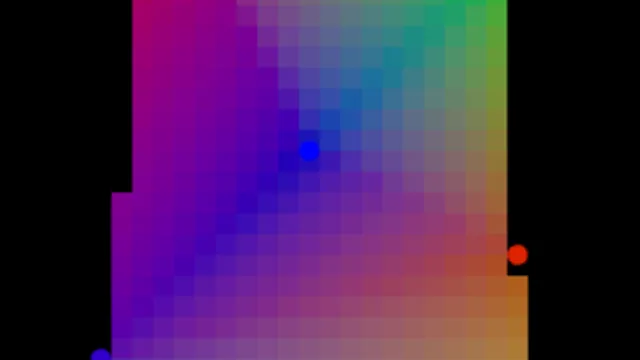Interpolation in any dimension with barycentric coordinates
Interpolation is a method used to create a new point in a data set without doing new measurements, using the existing points. It can be used to create a continuous function from a set of points, and can have applications in various domains: it can be used to scale up the frame rate of a video, to predict phenomenons with less measurement, etc. In this article, we will try to find an efficient method that can handle a lot of parameters.
Analytics
Comments
5.9
A interesting, well-motivated subject matter. Your writing style is enjoyable and your argumentation thorough. Visualizations were impressive, more of them would have been very welcome in the definition of barycentric coordinates to break up the dry proofs and formulas. Your idea for bypassing triangulation is interesting, even more so if it is original; although I'm not confident the complexity of triangulation outweighs the errors seen in your solution.
In the future, I recommend using an actual dot '•' instead of a full stop '.' to denote the dot product. I would also like to note that 'tho' is not the correct spelling of the word, and there is no space before a semicolon. These minor mistakes had no effect on my reading experience however.
5
What you've presented and coded up is impressive because it probably took considerable time to present the visual parts that pointed to the outputs of parameters. I'd recommend spending some more time clarifying the problem statement. The last sentence in that paragraph, "More precisely,..." isn't too clear for the claim of precision. I'd cite the other methods for the reader's choosing. I'd also expand on the more specific problem in the same statement. Or, perhaps set a quote block? Nonetheless, this was a fascinating read and keep it up!
7.3
Visualizations and content were amazing, but the narrative lost me a little bit
5.3
There is an extraneous closing parenthesis in “all fit) in dimension n defined by the point)”. I think the last word should be “points”.
“an Euclidean space” should be “a Euclidean space”.
5.2
Nice article. There are a few points where I struggled to follow, but I liked the interactivity and the ability to hide or show proofs as desired.
5.9
Bonus points for providing a /bad/ example to show what can go wrong.
[Second repeat of same feedback]
6.4
Article is too technical for an average reader, but for readers with prerequisites, provides lots of insights. Visuals are very good, but I would want to see more of them. Barycenter should be explained simple and with more visuals. Overall, a very good article.
5.2
This article is good in some aspects... I mean is totally a technic one and oriented to a specific problem... To follow it it is necesary to have a good idea of several maths concepts... It is not oriented to a big audience even if we talk of the public that is interested in the SoME exposition....
The explanation do not give any clue to leverage the difficulties involved in the subject ...
All in all, nothing special...
6
I think this provides a good introduction to spatial interpolation and I liked the discussion on why we needed more complex forms of interpolation besides simple weighting. I also liked the interactivity of the charts, and I think explicitly making it clear that it's interactive would help capture the imagination more.
There were some parts, which could be improved a bit more rigour, such as how the height visualization translated into the area one and I would have liked that this approach be used for the initial problems to see if those could be solved using this new method. It'd be good to also discuss further extensions for additional reading as well.
7.1
This entry is really well done! I really liked the simulations - they were interactive, but they also got the point across! I also liked the process by which you got the end answer, and how you made small, intuitive steps instead of big leaps.
I think your explanation of barycentric coordinates was a little bit too technical - you did provide some of the intuition behind it, but I think it would've been a little better to give the intuitive explanation (splitting a triangle up into smaller ones, then defining a coordinate based on the ratios of the areas) and then get into the technical one. They're both well explained, though, so it's a minor point at most.
3
None of the images showed up for me
7.1
10/10 on the interactives, explanations, and motivation. I'm curious about how this does in "reality". Might be helped by an example with removed data to test the "accuracy" of the method. Overall, great.
